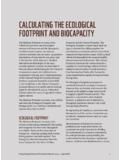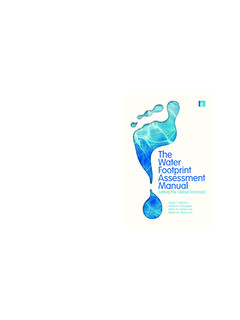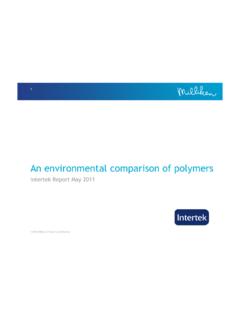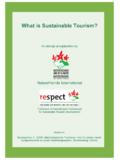Transcription of WWF SWEDEN 2008: An Analysis of Sweden’s …
1 WWF SWEDEN 2008: An Analysis of SWEDEN s Carbon Footprint 2 Report for WWF prepared by Jan Minx, Kate Scott, Glen Peters* and John Barrett Stockholm Environment Institute, University of York, Heslington, YO10 5DD, UK *Industrial Ecology Programme, Norwegian University of Science and Technology (NTNU), NO-7491 Trondheim, Norway 3 Contents Executive summary 4 7 1. Introduction 8 Living beyond limits 8 Living in a changing climate 10 A low carbon SWEDEN governments, business and people acting together 12 Accounting for climate change the carbon footprint 13 Structure of the report 16 2. The Swedish situation 17 Trends in SWEDEN s territorial CO2 emissions 17 Drivers of industrial CO2 emissions 19 SWEDEN s carbon footprint 21 The carbon footprint of SWEDEN s imports 24 3.
2 The carbon footprint of households 28 4. The carbon footprint of government 32 5. Businesses: sectoral contributions to the carbon footprint 34 6. Towards a low carbon SWEDEN 40 7. References 43 Methodology 45 Methodology references 48 4 Towards a low carbon SWEDEN : executive summary ecological debt day arrives earlier each year our insatiable consumer wants are driving us to use up the Earth s resources at a rate which the planet cannot regenerate them, known as overshoot. Yet these consumption patterns are not met equally around the world, instead the poverty gap is widening. Growing populations in the poorest parts of the world is putting even more pressure on them to meet their basic needs for food, water and shelter. Figure I shows the trend in global CO2 emissions in the last century, highlighting that in 1956 we started releasing more carbon dioxide into the atmosphere than the recommended volume necessary to keep our climate stable (70% below current levels, Stern, 2007).
3 Figure I: Global carbon dioxide emissions overshoot (adapted from Marland et al., 2007) We are releasing more carbon dioxide into the atmosphere than can be absorbed by ecosystems, oceans and geological systems. There are signs already today that global pollution is too much for the planet to cope with: our climate is warming causing ice sheets to melt and sea levels to rise, droughts and flooding are increasingly common, crops are failing and species are becoming extinct. These are strong signals that we need to deal much more carefully with our planet s resources, if we want to avoid ecological disaster. It is the world s poorest countries that are most vulnerable to the effects of global warming and ecological disaster as they do not have the resources to cope.
4 Industrialised countries have developed their economies, 5 and as a result are responsible for the majority of carbon dioxide in the atmosphere today. Poorer countries will need to increase their emissions to allow more people to meet their basic needs, and so industrialised countries must therefore lead the way out of crisis by drastically reducing global emissions. This is recognised as economically the most efficient solution to deal with climate change. Leading SWEDEN to a low carbon economy is not an easy route to take, but it will secure the future for SWEDEN , providing a better quality of life for all. No one is exempt from the effects of climate change. We must make immediate changes to the way we produce and consume goods and services in order to contribute to the necessary global reductions of CO2 emissions This report assesses SWEDEN s contribution to climate change from two perspectives: SWEDEN s territorial CO2 emission account and SWEDEN s carbon footprint.
5 Whilst CO2 is just one of several greenhouse gases and climate change is just one of the implications of resource overshoot, they represent the greater part of the problems we face today. We have highlighted the issues associated with purely taking territorial emissions into account, which does not reflect the full climate change impacts of life in SWEDEN . The global climate change impacts of Swedish citizens are 17% higher than suggested by the territorial emission account, and so unless the territorial emission account is adjusted to include emissions embodied in traded products consumed within SWEDEN , SWEDEN s contribution to climate change, like most other industrialised countries, will be under-estimated. To achieve a low carbon economy, SWEDEN must reduce greenhouse gas emissions from its territory, whilst also reducing global emissions from consumption, addressing the production of products in other countries.
6 The Analysis of the Swedish context results in the following conclusions and raises some key areas for policy consideration: SWEDEN has not succeeded in reducing its territorial emissions since the start of climate change negotiations in 1992 SWEDEN has shown its commitment to climate change and has been acknowledged as a leader in climate performance and will succeed in achieving its Kyoto targets, allowing SWEDEN an overall increase in emissions of 4% 1990 levels, within the EU combined reduction target of 8%. However, maybe due, therefore, to a lack of motivated policy goals, SWEDEN has not succeeded in reducing its territorial emissions since the start of climate change negotiations in 1992, over 15 years ago. Current levels of CO2 emissions are not enough to prevent dangerous climate change and SWEDEN must push for more ambitious reductions.
7 In order to reduce domestic emissions in line with necessary longer term climate targets, policy needs to focus on energy, transport and food. Technological carbon-efficiency improvements have been achieved in all sectors, with the exception of agriculture, forestry and fishing and much more notably the transport sector. The majority of the transport industry is reliant on fossil fuels, mainly oil. The government needs to see though its target of ending its dependence on oil by 2020. This should not be at the expense of increasing its reliance on nuclear power. 6 There are more than enough renewable energy sources in SWEDEN to provide a diverse, secure low carbon electricity supply, alongside appropriate options for improvements in energy efficiency.
8 Nuclear power comes with considerable uncertainty and risk, and the option of increasing biofuel use is also not without controversy. It is important to note that the carbon tax and energy certificates promote investment in the least cost renewable resources, which is creating a firm demand for biofuels. However, biofuels have been criticised for causing a loss in biodiversity, placing increased pressure on water resources, adding to deforestation and taking away land that could feed a growing world population. This demand for biofuels, partly due to its cost effectiveness compared with other alternatives, does not encourage wind power, which needs strong, targeted support. SWEDEN s carbon footprint is higher than its territorial emissions, with the majority of CO2 attached to imports coming from the EU Territorial emissions do not reflect the full climate change impacts of Swedish citizens.
9 When taking global consumption emissions into account, SWEDEN s emissions are 17% higher. Therefore, the government s framework must take account the CO2 attached to traded products. It s too easy to say that Swedish consumers should be held fully responsible or that SWEDEN should take care of all these emissions as they have paid for the products. Yet it is more an issue of costing not taking into account the full externalities of the product, such as the environmental impacts of that product. Another important issue relating to this is the current design of the Kyoto Protocol that means Non-Annex parties, such as China and India, have no targets to meet (as oppose to Annex I parties such as SWEDEN ) as of yet. Industrialised countries need to be aware of this and make efforts to help reduce these emissions through mechanisms outlined in the Kyoto agreement.
10 As the majority of emissions attached to Swedish imports are from the EU (40%), SWEDEN should continue to be a leader in sustainability policies within the EU and push for stronger climate change agreements between Member States. The EU Emission Trading Scheme is having little success as caps (the overall limit of emissions per country) have been set too high, meaning that countries do not need to trade for carbon allowances. Most importantly, SWEDEN should ensure trading takes place by pushing for considerable reductions of caps. This will add to greener supply chains for products consumed by its inhabitants through reduced CO2 embedded in imports. Over three quarters of SWEDEN s greenhouse gas emissions come from households mainly energy, transport and food In the past policies have focused on industry and cleaner production.






